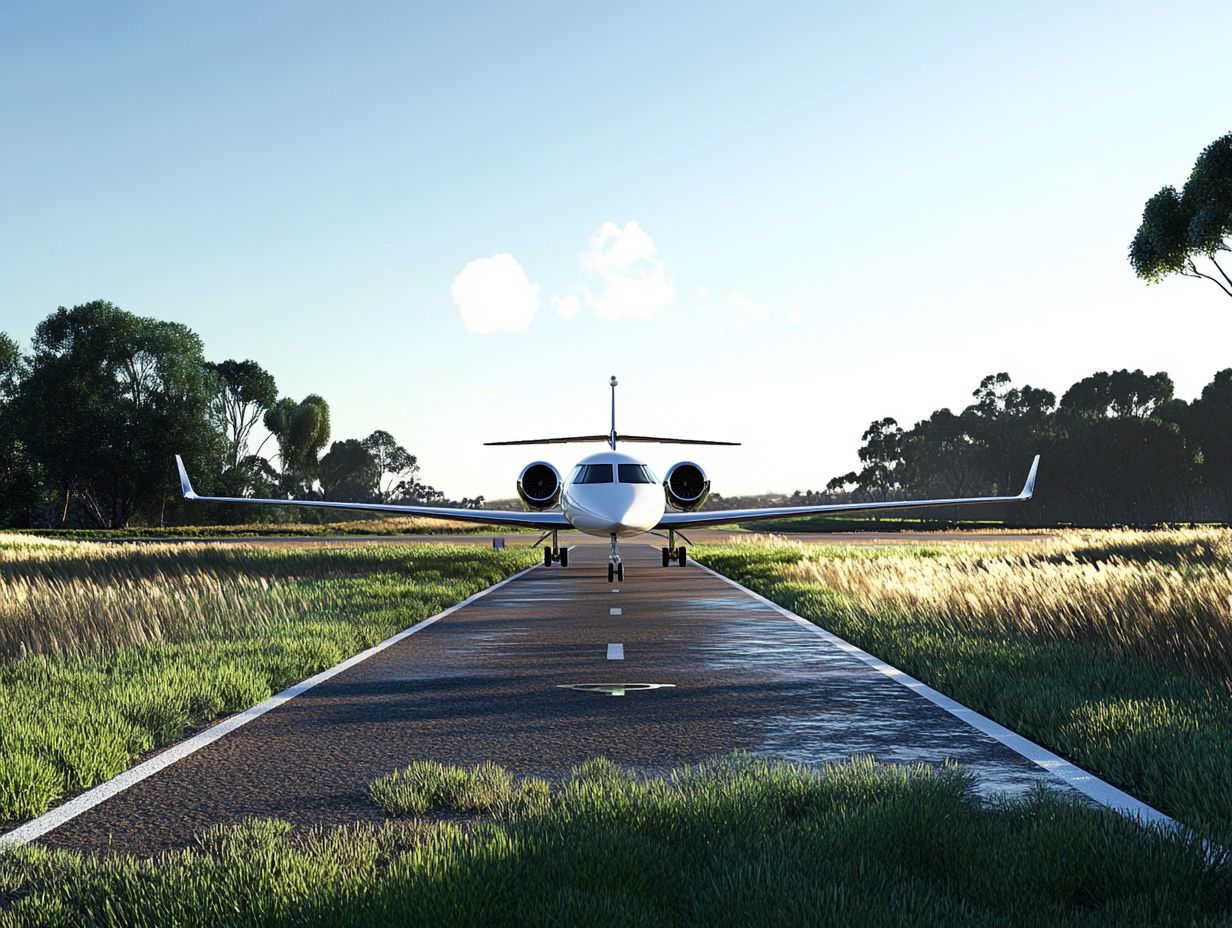When I think about private jets, I wonder about what jets need for runways. These needs can change a lot because of things like how heavy the jet is, how big it is, the weather, and what the runway is like.
In this article, I will check out what makes runway needs change. I will also show how to figure out how far planes need to go to take off and land safely.
Things That Change Jet Runway Needs

When I think about what makes jet runway needs different, I see there are a bunch of things, like the type of plane, how heavy it can be, and how long the runway is. Each thing is really important for knowing what’s needed to take off safely.
For example, bigger jets like the Airbus A380 and Gulfstream G650 have completely different requirements than smaller jets like the Cirrus Vision Jet or Cessna 172. Plus, I can’t forget about environmental factors such as air temperature, elevation, and air density.
These things really matter because they impact engine thrust and takeoff speed, which in turn affects the runway needs at airports like Teterboro and Paris Le Bourget.
Jet Weight and Size – Why They Matter!

The weight and size of a private jet are really important for runway needs. They change how heavy it can be when it takes off and how long the runway needs to be.
In terms of bigger jets like the Gulfstream G650 and Bombardier Global 6000, I know they often need longer runways—usually over 5,000 feet—because they are heavier.
On the flip side, smaller jets like the Embraer Phenom 300 and Cessna Citation can get by on much shorter strips, sometimes needing as little as 3,000 feet.
This size difference not only boosts operational efficiency, letting those smaller jets access smaller airports, but it’s also crucial for safety during takeoff and landing.
So, it’s clear that understanding the different runway requirements based on aircraft size is key for flight planning and making the most out of travel routes.
Weather – What You Should Know!

Weather is really important for private jets. Stuff like how hot it is and humidity can change how fast a plane takes off and how well it works on the runway.
For example, when the temperatures are high, the air density drops, which means I might need a longer runway to get off the ground successfully.
As a pilot, I often find myself changing my plans based on the local climate, especially in warmer areas or during those hot summer months. If I’m flying out of places like Atlantic City International Airport, I may need to plan for longer distances to reach optimal speeds as the heat and humidity rise.
That’s why I keep a close eye on real-time weather data. Sometimes, I’ll even tweak my flight plans or adjust the aircraft’s weight to ensure a safe departure.
Understanding how all these variables interact helps me operate more efficiently and safely in the ever-changing world of private aviation.
Runway Surface and Elevation – Why They Matter!

What the runway is made of and how high it is really matter for private jets. Choosing between asphalt and concrete for runways can change how a plane works.
In terms of choosing between asphalt and concrete for runway surfaces, it can really influence how an aircraft performs. I’ve found that asphalt offers a more flexible surface, which helps absorb stress from the aircraft. On the other hand, concrete gives a more rigid and durable option that can handle heavy loads over time. Also, when the runway is higher up, the air gets thinner, making engines work less well, so I need longer runways to take off and land.
I follow FAA rules because they help keep things safe and sound.
How to Find Out Runway Needs
When I figure out runway needs for private jets, I need to know the basic takeoff and landing distances. There are many things to think about, like how heavy the plane is and what kind of plane it is, like an Airbus A320 or a Gulfstream G650.
I also gotta think about density altitude, which can change a lot of stuff. It’s all about getting the details right to ensure a smooth takeoff and landing.
Takeoff and Landing Distances to Know
When it comes to takeoff and landing distances for private jets, I learned that they can change a lot based on the type of plane and how heavy it is. This makes it really important for me as a pilot or operator to have a solid grasp of these metrics when planning my flights.
These distances aren’t just about the model itself; they’re also affected by things like runway surface conditions and the weather. Those factors can either stretch out or shrink the distances I need.
For instance, the Bombardier Global 6000 usually needs about 5,200 feet to take off when it’s super heavy, while the lighter Embraer Phenom 300 can take off in just 3,200 feet when things are good.
Getting these details is super important for me to make things work better and stay safe. I’ve seen how variations in payload and runway characteristics can lead to some pretty dramatic changes in performance metrics, so staying informed is key.
Other Things to Think About
When I’m figuring out runway needs for private jets, I don’t just look at the basic numbers. There are tons of other factors that come into play, like weather conditions, the type of aircraft, and how elevation impacts performance.
For example, regional regulations can specify the minimum runway length needed for different aircraft based on their capabilities. I’ve noticed that airports in mountainous areas often have to deal with elevation challenges that can really affect an aircraft’s lift during takeoff.
I watch the weather because storms or weird winds can mess up flight plans. Just think about private airports in Florida—those summer storms mean pilots have to think about longer safe distances for takeoff.
And get this: statistics indicate that altitude can cut performance by about 10%. So, it’s obvious how important it is to think about all this stuff when planning.